Saturn S series
| Saturn S series | |
|---|---|
|
| |
| Overview | |
| Manufacturer | Saturn Corporation |
| Production | 1990–2002 |
| Assembly | United States: Spring Hill, Tennessee (Spring Hill Manufacturing) |
| Body and chassis | |
| Class | Compact car |
| Layout | Transverse front-engine, front-wheel drive |
| Platform | GM Z platform |
| Chronology | |
| Successor | Saturn ION |
The Saturn S series was a family of compact cars from the Saturn automobile company of General Motors. This was the first series of Saturn vehicles. The automobile platform, the Z-body, was developed entirely in-house at Saturn, and it shared very little with the rest of the General Motors model line. It implemented a spaceframe design, which had been used on some Pontiacs during the 1980s. This meant that the side panels did not carry load and could be made of plastic instead of metal. These polymer panels were dent-resistant, something that remained a selling point for Saturn until just a few years before the Saturn brand was discontinued. The S series was sold from the fall of 1990 for the 1991 model year through the end of the 2002 model year. Significant design updates were made in 1995, 1996, and 2000 for all cars, and the SC coupes were redesigned significantly in 1997. Nearly every year of the S series's existence brought at least some minor changes to the architecture of the car.
The S series debuted with SL, SL1, and SL2 sedan models and the SC coupe model in 1990 for the 1991 model year. For the 1993 model year they were joined by the SW, SW1, and SW2 station wagon variants of the SL, and a lower-end coupe called the SC1 was added. It is rumored that the SL sedan models were to be called the SS for Saturn Sedan, but due to the usage of the SS moniker by GM marques such as Chevrolet, GM corporate would not allow it.
The 1 or 2 (or lack thereof) in the model designation signifies which engine the vehicle has, and transmissions were kept specific to each engine. The S series all used either the SOHC LK0/L24 or the DOHC LL0 version of the completely original, designed in-house Saturn 1.9L engine. Logically, the 1 designates a vehicle with an SOHC engine, whereas a 2 designates a vehicle with a DOHC engine. SL and SW models with no number are base models, with all manual options and the SOHC engine. Conversely, the 1991-1992 SC models were only offered with the DOHC engine, and in 1993 they were redesignated the SC2. Cars with the SOHC engine were only offered with the MP2 manual transmission and the MP6 automatic, while cars with the DOHC were only offered with the MP3 manual and MP7 automatic. The only difference in each case is the selection of gear ratios, with the SOHC-associated transmissions being geared taller for more efficiency, and the DOHC-associated transmissions having shorter, more closely spaced ratios for performance. As a result, it is common for owners to swap a tall-geared MP2 manual into a car equipped with a DOHC engine for better fuel economy on the highway.
Aside from the engine and transmission, the higher-end 2 models also included 15-inch instead of 14-inch wheels, a correspondingly larger tire size, EVO steering, a rear swaybar, the option of rear disc brakes (standard on the 1991-1992 SC), color-matched bumpers and door handles, and more interior options.
Taiwan and Japan were the only two Asian countries to import Saturns. From 1992 to 1996, the first- and second-generation sedans plus the first-generation coupes were sold in Taiwan. From 1997 to 2001, the second-generation versions were sold in right-hand drive in Japan, and some Toyota Netz dealerships, and former Isuzu dealerships did offer Saturn products until 2001. At the time of the Japanese launch, the Japanese economy was in a sharp decline after the Japanese asset price bubble had collapsed during the early 1990s.
Canada imported all available Saturn models from 1992 onward.
A change beginning with the 1999 model year gave the SC a small suicide door on the driver's side. This type of door had previously been used in extended cab pickup trucks, but was an innovation in coupe design.[1]
The S series was replaced by the larger Saturn ION in 2002 for the 2003 model year, which was unable to match the S-series sales numbers, efficiency, or reliability before the end of the ION's production at the end of 2007.
S-series cars equipped with the base single overhead cam engine and a manual transmission were among the most fuel-efficient cars available in the United States when they were produced, reaching 40 miles per US gallon (5.9 L/100 km; 48 mpg‑imp) in EPA highway tests at the time (this would likely translate to 36 miles per US gallon (6.5 L/100 km; 43 mpg‑imp) under current methodologies).[2]
First generation
| First generation | |
|---|---|
 | |
| Overview | |
| Also called |
Saturn SL Saturn SW Saturn SC |
| Production |
1990–1995 SL 1993–1995 SW 1990–1996 SC |
| Body and chassis | |
| Body style |
2-door coupe 4-door sedan 5-door station wagon |
| Powertrain | |
| Engine |
1.9 L LK0 I4 (Gasoline) 1.9 L L24 I4 (Gasoline) 1.9 L LL0 I4 (Gasoline) |
| Transmission |
4-speed Saturn MP6 automatic 4-speed Saturn MP7 automatic 5-speed Saturn MP2 manual 5-speed Saturn MP3 manual |
| Dimensions | |
| Wheelbase |
SL & SW: 102.4 in (2,601 mm) SC: 99.2 in (2,520 mm)[3] |
| Length |
SL & SW: 176.3 in (4,478 mm) 1990–93 SC: 175.8 in (4,465 mm) 1994–96 SC1: 173.2 in (4,399 mm) 1994–96 SC2: 174.6 in (4,435 mm) |
| Width | 67.6 in (1,717 mm) |
| Height |
SC: 50.6 in (1,285 mm) SL: 52.5 in (1,334 mm) SW: 53.7 in (1,364 mm) |
| Curb weight |
SC: 2,293.9–2,416.7 lb (1,040–1,096 kg) SL: 2,320.5–2,456.5 lb (1,053–1,114 kg) SW: 2,397.3–2,499.4 lb (1,087–1,134 kg) |
First generation SL
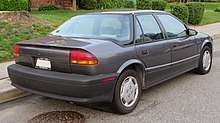
The first generation SL was constructed for model years 1991 through 1995, with the first Saturn to leave the assembly line in the Spring Hill, Tennessee factory was on July 30, 1990, the same day that then-CEO of GM, Roger Bonham Smith, retired. It was maroon with a tan interior.
From 1991 to 1992, the Saturn SL-series Sedan trim levels consisted of the SL, the SL1, and the SL2.
The base SL model featured the MP2 manual transmission only, and it had manual steering. The SL1 trim level featured the option of the same MP2, or the MP6 automatic transmission. Both were offered only with the SOHC 1.9L I4 LKO engine that produced 85 hp (63 kW), which was rated at 27 mpg (8.7L/100 km/32 mpg) City, 34 mpg (6.9L/100 km; 41 mpg) Highway. The SL2 trim level featured the MP3 manual transmission, or the MP7 automatic transmission, both exclusively with the DOHC 1.9L I4 LL0 engine that was rated at 124 hp (92 kW), 24 mpg (9.8L/100 km; 29 mpg) City, 34 mpg (6.9L/100 km; 41 mpg) Highway.
First generation SW
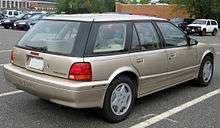
For the 1993 model year, a station wagon variant of the SL with SW1 and SW2 trim levels was added to the model lineup.
For the 1995 model year, the seatbelts were changed from the power passive restraint type to the conventional 3-point type. The interior of the vehicle was redesigned with a new dashboard and the addition of a front passenger's airbag. The center console was updated as well, adding previously absent cup holders. Also for 1995, the SOHC (LK0) engine was given MPFI to create the 100 hp (75 kW) L24 engine.
The S series also had a 12.8 US gallons (48L; 11 imp gal.) fuel tank, which means that both the SL and the SW models had both gotten around 384 miles (618 km) on a single tank based on an average of 32 mpg (7.4L/100 km; 38 mpg) Owners of the SL1 model would usually report real-world fuel mileage of about 38-41 mpg (6.2-5.7L/100 km; 46-29 mpg) on the Highway with the manual transmission.
First generation SC
The first generation Saturn SC coupes were made from 1991 to 1996. The first generation Saturn SC coupes were originally just only available in one trim level which was the SC.
The 1991-1992 Saturn SC had featured a DOHC 1.9L L14 LL0 engine that was rated at 124 hp (92 kW). For the 1993 model year, the original regular SC coupe model was renamed as the SC2 and a new SC1 trim level was introduced. For the 1994 model year, the SC1 and the SC2 had both gotten revised power door locks and a recalibrated automatic transmission. The first generation SC2 had received a minor refresh in 1995 in which the lower front bumper and the vehicle's taillights were both updated. For the 1995 model year, both the SC1 and the SC2 had gotten a redesigned interior with a new redesigned dashboard with a front passenger's airbag.
The first generation SC1 coupe had featured a SOHC 1.9L I4 LKO engine that was rated at 85 hp (63 kW). The SC1's engine was later upgraded to the 100 hp (75 kW) L24 engine for the 1995 model year.
The first generation Saturn SC1 coupes had shared the same front fascia with the SL sedans and the SW station wagons rather than the SC2. The SC1 had also lacked a rear trunk lid reflector and a rear stabilizer bar.
- 1990-1995 Saturn SC/SC2
 1995-1996 Saturn SC2
1995-1996 Saturn SC2- Saturn SC1
Second generation
| Second generation | |
|---|---|
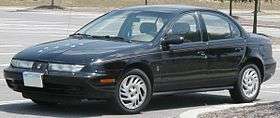 | |
| Overview | |
| Also called |
Saturn SL1 Saturn SL2 Saturn SW1 Saturn SW2 Saturn SC1 Saturn SC2 |
| Production |
1996–1999 SL 1996–1999 SW 1997–1999 SC |
| Body and chassis | |
| Body style |
2-door coupe (1997–1998) 3-door coupe (1999-2002) 4-door sedan 5-door station wagon |
| Powertrain | |
| Engine |
1.9 L L24 I4(Gasoline) 1.9 L LL0 I4(Gasoline) |
| Transmission |
4-speed Saturn MP6 automatic 4-speed Saturn MP7 automatic 5-speed Saturn MP2 manual 5-speed Saturn MP3 manual |
| Dimensions | |
| Wheelbase | 102.4 in (2,601 mm) |
| Length |
1996–99 SW & 1996–97 SL: 176.8 in (4,491 mm) 1998–99 SL: 176.9 in (4,493 mm) |
| Width |
1996–99 SW: 66.7 in (1,694 mm) 1997–2000 SC: 67.3 in (1,709 mm) 1996–99 SL: 66.7 in (1,694 mm) |
| Height | 1996–99 SW & SL: 54.5 in (1,384 mm) |
Second generation SL and SW
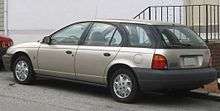
The second generation SL sedans and SW station wagons were made from 1996 to 1999. They had both featured a completely redesigned exterior. The interior was mostly the same from the 1995 model year vehicles.
The redesigned second generation S series went on sale in 1995 for the 1996 model year.
Although the SL sedans and the SW station wagons were both redesigned for the 1996 model year on the exterior, mechanically very little was changed from the first generation S-series vehicles.
A few minor changes were made for the 1998 model year S-series vehicles. Due to multiple complaints about the noise coming from the vehicle's trip odometer that had been in all of the Saturn S series since 1995, had replaced with a new type of trip odometer in an effort to correct the problem. For the 1998 model year, a new cluster with a digital trip odometer had been introduced. Rear disc-brakes were no longer available as an option on the S series due to high costs for them as well as very little improvement in braking performance over the conventional rear drum-brakes setup.
Beginning with all of the Saturn S-series vehicles that were made in late 1999 (sometimes referred to as 1999.5 models) had received improvements to both the SOHC and the DOHC engines in the S series. These changes included revised pistons, new connecting rods, and new crankshaft counterweights in the engine as well. The Twin Cam cylinder head had now featured a new roller-rocker setup with hydraulic tappets and roller cams replacing the conventional bucket lifter setup of the previous engine in the S series.
Also introduced for the 1999 model year S-series vehicles that were sold in California was a different type of an exhaust manifold that housed an upstream catalytic converter (this converter had heated up much faster than the conventional unit, and it had also decreased exhaust emissions faster as well), and it also had provisions for an air-injection reaction system (This had injected fresh air into the exhaust to reduce hydrocarbons during the startup of the vehicle, and it wouldn't also help the oxygen sensors and catalytic converters reach operating temperatures faster). These vehicles were made to meet the all-new CARB ULEV standards for the 1999 model year.
Second generation SC
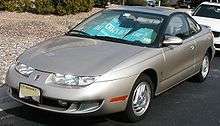
The second generation SC coupes were made from 1997 to 2000. The second generation SC coupes had also moved to the longer wheelbase that the SL sedans and the SW station wagons had used, resulting in an equal wheelbase length across all S-series models. The redesign had resulted in a more curved look for the SC coupes, which gave a slight increase in the vehicle's interior room/space, as well as doorway size as well as a completely redesigned exterior of the vehicle itself. For the 1999 model year, a suicide door was added to the driver's side of the vehicle, which had been a revolution in coupe bodystyle type of vehicles. Even though the suicide door on the driver's side of the vehicle had allowed easier access into the vehicle's rear seat, the driver's seat in the vehicle was also able to slide forward and to fold down forward somewhat to also allow an easy access into the vehicle's rear seat as well. The suicide door on the driver's side of the SC coupes could not open unless the front driver's door was open because the door handle the driver's side suicide door was on the inside of the suicide door itself. Like the first generation SC coupes, the SC1 model lacked a rear sway bar.
Third generation
| Third generation | |
|---|---|
|
| |
| Overview | |
| Also called |
Saturn SL1 Saturn SL2 Saturn SW1 Saturn SW2 Saturn SC1 Saturn SC2 |
| Production |
2000-2002 SL 2000-2002 SW 2000-2002 SC |
| Body and chassis | |
| Body style |
3-door coupe 4-door sedan 5-door station wagon |
| Powertrain | |
| Engine |
1.9 L L24 I4(Gasoline) 1.9 L LL0 I4(Gasoline) |
| Transmission |
4-speed Saturn MP6 automatic 4-speed Saturn MP7 automatic 5-speed Saturn MP2 manual 5-speed Saturn MP3 manual |
| Dimensions | |
| Wheelbase | 102.4 in (2,601 mm) |
| Length |
2000–02 SL & SW: 178.1 in (4,524 mm) 2001–02 SC: 180.5 in (4,585 mm) |
| Width |
2000–01 SW: 66.4 in (1,687 mm) 2001–02 SC: 68.2 in (1,732 mm) 2000–02 SL: 66.4 in (1,687 mm) |
| Height |
2000–01 SW: 55.6 in (1,412 mm) 2000–02 SL: 55 in (1,397 mm) 2001–02 SC: 53 in (1,346 mm) |
Third generation SL and SW
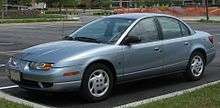
In 1999 for the 2000 model year, the Saturn S series had been redesigned for the final time before the S series had been discontinued in 2002. This resulted in the third generation Saturn S series.
The exterior of the Saturn SL sedans revived new body panels from the belt-line down. The rear end of the SL sedans received a redesigned applique on the trunk, and the headlights of the SL sedans had received orange turn signal-hazard lights indicator.
The interior of all the Saturn S-series models received a completely redesigned dashboard, center console, and steering wheel, but the rest of the interiors were mostly unchanged. The SL2, SW2, and SC2 got the storage compartment with a sliding arm rest in the center console as standard. Where as the SL1, SW1, and SC1 did not.
Like the 1999 model year SL sedans and the 1999 model year SW station wagons that were made in late in 1999, the 2000 model year SL sedans and the 2000 model year SW station wagons had also included a digital trip odometer, which did not cause any issues like the analog trip odometers that were used in the 1991-early 1999 model year S-series vehicles.
The third generation Saturn S series was also the first Saturn to use the body control module (BCM), and the powertrain control module (PCM) systems in tandem with each other. In the third generation Saturn S-series models, the PCM system was used strictly for the vehicle's transmission and engine, whereas the BCM system was used strictly for the vehicle's interior functions such as the digital trip odometer and speedometer.
Beginning with the 2001 model year, side curtain airbags became available as an optional feature. The optional side curtain airbags were only available on the 2001 to 2002 model Saturn SL1 and SL2 sedans.
Third generation SC

The third generation of Saturn SC maintained the SC1 and SC2 models. They were essentially identical to the second generation SC in all terms except appearance where minor updates were done to improve the lines[4] and a PCM and BCM were added. A new GT trim package had become available for the Saturn SC coupes for the 2001 model year, along with the option of American Racing Wheels that was only available on the GT version of the Saturn SC coupes. A rear spoiler on the vehicle's rear trunk lid was also made available for the 2001 to 2002 model year Saturn SC GT coupes.
Special edition Saturns
A special Homecoming edition of the SL2 was released for 1994. It had special Pearl White paint (a "silver-tint" pearl, shared with Cadillac models of this year), black Saturn emblems, spoiler, 15 in (381 mm) "teardrop" wheels, anti-lock four-wheel disc brakes, grey leather/cloth interior, rear headrests, fog lamps, and power locks and windows. Options included a sunroof, CD player, and the 4-speed automatic with traction control.
In 1998 and 1999, prospective buyers of a red or white SC2 had the option of purchasing the "Black Top Coupe Package" for $225.00 (US). The models were referred to as the "Red Hot Coupe" or "White Hot Coupe", based on the exterior color. The package came with a black roof panel, black outside rear view mirrors, black emblems, white face gauges and black accented teardrop wheels. These are extremely rare.
In 1999, a second Homecoming Edition was produced in a special "Mint Color" with tan leather interior, special off-white gauge faceplates, and black Saturn badges to commemorate the second "Homecoming" visit to the Spring Hill, Tennessee manufacturing facility. The 1999 Homecoming Edition also had the same features offered as the 1994 Homecoming Edition.

In 2001, a special yellow SC2 coupé model was also built. The model was officially named "Limited Edition", but soon became known as the "Bumblebee Edition". 99 were produced, each with a certificate of authenticity. The "Bumblebee Edition" included embroidered headrests, black leather interior with yellow leather inserts on the seats and door panels, black roof and mirrors, number designation inside fuel filler door and certificate of authenticity. These are not to be confused with the regular issue Yellow Sport Coupe.
For the 2001 model year, a special edition of the Saturn SL2 sedan that was called the 2001 Saturn SL2 10th Anniversary Edition (also known as the Silver Anniversary Edition) was made available. The Saturn SL2 10th Anniversary Edition was only available for the 2001 model year only. The 2001 Saturn SL2 10th Anniversary Edition had included several upscale features that were not available on any other Saturn S-series vehicles like power windows, leather interior, standard side curtain airbags, and several other upscale features. The 2001 Saturn SL2 10th Anniversary Edition also had "Saturn 10th Anniversary" stitched onto the front seat adjustable leather headrests. The 2001 Saturn SL2 10th Anniversary Edition had also featured a rear spoiler on the vehicle's rear trunk lid.
| 1994 Homecoming Edition | 3,500 |
| 1998 White Hot Coupe | 213 |
| 1998 Red Hot Coupe | 657 |
| 1999 White Hot Coupe | 285 |
| 1999 Red Hot Coupe | 284 |
| 1999 Homecoming Edition | 4,000 |
| 2001 Limited Edition SC2 | 99 |
| 2001 10th Anniversary Edition | 1,000 |
| 2001 Bright Red | 664 |
Right-hand drive
In addition to the above-mentioned "Special Edition" Saturns; there was also the 1999–2001 Saturn SWP "Postal" station wagon that were produced (450 in 1999), intended to be marketed to rural route mail carriers. These station wagons were right-hand-drive vehicles.
There were also a limited number of Saturns that were exported to Japan as right-hand-drive vehicles circa between 1997 and 2000. Aside from having the steering wheel on the other side, Japanese market Saturns were also fitted with slightly different light units. The rear lamps had amber turn signals and the front indicators were mounted closer to the corners rather than inboard.
The Saturn faced a hard time in Japan, where it played directly into the strengths of the Japanese manufacturers, comparing unfavorably with better-priced and more competent Japanese compact cars.[5] The interior, especially, received criticism.[6] A mere 602 units were sold in Saturn's first year in Japan (April to December 1997).[7]
Another problem was that Japanese car dealers have always excelled at customer service; this meant that Saturn's main sales argument in the United States was meaningless in the Japanese market.[8] The introduction of Saturn was also ill-timed, as the economy was in the midst of a recession due to the effects of the 1980s "bubble economy". As the Japanese had less money to spend on "luxury goods", as imported products are regarded, Saturn found very few buyers.
Theft
The 1995 Saturn SL was the most stolen vehicle in 2003, while the 1994 SL took third place in CCC Information Services's 2003 most stolen vehicle report.[9] According to the Lynnwood, Washington police department, when use of the key wears on the door and ignition mechanisms, a filed blank key can be used to open the door and start the engine.
Racing
Saturn SC's competed in the SCCA World Challenge in the 1990s, winning several races from 1995 to 1997.[10][11][12] Several S-series cars have been used as rally race cars. S-Series cars are also popular in dirt oval racing and auto cross.
Safety
Insurance Institute for Highway Safety (IIHS)
| Moderate overlap frontal offset | Acceptable |
| Small overlap frontal offset | Not Tested |
| Side impact | Not Tested |
| Roof strength | Not Tested |
NHTSA
| Year | Frontal Driver | Frontal Passenger | Side Driver | Side Passenger | 4x2 Rollover |
|---|---|---|---|---|---|
| 1991 | Not Rated | Not Rated | Not Rated | ||
| 1992 | Not Rated | Not Rated | Not Rated | ||
| 1993 | Not Rated | Not Rated | Not Rated | ||
| 1994 | Not Rated | Not Rated | Not Rated | ||
| 1995 | Not Rated | Not Rated | Not Rated | ||
| 1996 | Not Rated | Not Rated | Not Rated | ||
| 1997 | Not Rated | ||||
| 1998 | Not Rated | ||||
| 1999 | Not Rated | ||||
| 2000 | Not Rated | ||||
| 2001 | |||||
| 2002 |
Production numbers
Listed below is a rough estimate on the numbers of S series produced from 1990 to 2002.[26]
| Year | Coupe | Sedan | Wagon | Total | ||||||||
|---|---|---|---|---|---|---|---|---|---|---|---|---|
| SC | SC1 | SC2 | Total | SL | SL1 | SL2 | Total | SW1 | SW2 | Total | ||
| 1991 | ~10,000 | - | - | ~20,000 | ~38,629 | - | - | - | ~48,629 | |||
| 1992 | - | - | - | - | - | 169,959 | ||||||
| 1993 | - | 244,621 | ||||||||||
| 1994 | - | 267,518 | ||||||||||
| 1995 | - | 62,434 | 221,102 | 19,452 | 302,988 | |||||||
| 1996 | - | 294,198 | ||||||||||
| 1997 | - | 70,711 | 213,182 | 31,099 | 314,992 | |||||||
| 1998 | - | 38,591 | 160,759 | 20,415 | 219,765 | |||||||
| 1999 | - | 52,965 | 203,578 | 19,090 | 275,633 | |||||||
| 2000 | - | 8,517 | 8,724 | 17,241 | 68,907 | 142,992 | 9,633 | 169,866 | ||||
| 2001 | - | 23,584 | 17,414 | 40,998 | 73,428 | 3,416 | 117,842 | |||||
| 2002 | - | - | - | - | ||||||||
References
- ↑ "BEHIND THE WHEEL/Saturn SC2; Finding a Jackpot Behind Door No. 3". nytimes.com. 1999. Retrieved 2012-07-30.
- ↑ "Compare Old and New EPA MPG Estimates: 1997 Saturn SL". United States Environmental Protection Agency. Retrieved January 27, 2010.
- ↑ http://oldcarbrochures.org/index.php/New-Brochures---May/1991-Saturn-Full-Line-Brochure/1991-Saturn-Full-Line-24-25
- ↑ unknown. "2002 Saturn SC". cars.com. Retrieved 7 April 2014.
- ↑ Latham, Scott (1998-05-13), Grinding Gears: The Japanese Auto Dealer Network and American Trade Complaints (PDF), Chester Springs, PA: Scott Latham Associates, p. 60
- ↑ Latham, p. 64
- ↑ Latham, p. 59
- ↑ Latham, p. 62
- ↑ "1995 Saturn SL Tops Most Stolen Vehicle List". saturnfans.com/. Retrieved 2008-04-03.
- ↑ "1995 World Challenge : Round 1" (PDF). Scca.cdn.racersites.com. Archived from the original (PDF) on 24 May 2013. Retrieved 23 February 2015.
- ↑ "1996 World Challenge" (PDF). Scca.cdn.racersites.com. Archived from the original (PDF) on 24 May 2013. Retrieved 23 February 2015.
- ↑ "SCCA Pro Racing Results : 1997 World Challenge Touring 1 Class" (PDF). Scca.cdn.racersites.com. Archived from the original (PDF) on 2013-05-24. Retrieved 2013-10-13.
- ↑ "IIHS-HLDI: Saturn SL". Iihs.org. Retrieved 2013-03-22.
- ↑ "1991 Saturn SL 4-DR. | Safercar – NHTSA". Safercar.gov. Retrieved 2013-03-22.
- ↑ "1992 Saturn SL 4-DR. | Safercar – NHTSA". Safercar.gov. Retrieved 2013-03-22.
- ↑ "1993 Saturn SL 4-DR. | Safercar – NHTSA". Safercar.gov. Retrieved 2013-03-22.
- ↑ "1994 Saturn SL 4-DR. | Safercar – NHTSA". Safercar.gov. Retrieved 2013-03-22.
- ↑ "1995 Saturn SL 4-DR. | Safercar – NHTSA". Safercar.gov. Retrieved 2013-03-22.
- ↑ "1996 Saturn SL 4-DR. | Safercar – NHTSA". Safercar.gov. Retrieved 2013-03-22.
- ↑ "1997 Saturn SL 4-DR. | Safercar – NHTSA". Safercar.gov. Retrieved 2013-03-22.
- ↑ "1998 Saturn SL 4-DR. | Safercar – NHTSA". Safercar.gov. Retrieved 2013-03-22.
- ↑ "1999 Saturn SL 4-DR. | Safercar – NHTSA". Safercar.gov. Retrieved 2013-03-22.
- ↑ "2000 Saturn SL 4-DR. | Safercar – NHTSA". Safercar.gov. Retrieved 2013-03-22.
- ↑ "2001 Saturn SL 4-DR. | Safercar – NHTSA". Safercar.gov. Retrieved 2013-03-22.
- ↑ "2002 Saturn SL 4-DR. | Safercar – NHTSA". Safercar.gov. Retrieved 2013-03-22.
- ↑ Auto Editors of Consumer Guide (2002). The Encyclopedia of American Cars. Publications International.
| Wikimedia Commons has media related to Saturn S series. |
Saturn automobile timeline, 1991–2010 | ||||||||||||||||||||
|---|---|---|---|---|---|---|---|---|---|---|---|---|---|---|---|---|---|---|---|---|
| Type | 1990s | 2000s | 2010s | |||||||||||||||||
| 1 | 2 | 3 | 4 | 5 | 6 | 7 | 8 | 9 | 0 | 1 | 2 | 3 | 4 | 5 | 6 | 7 | 8 | 9 | 0 | |
| Sports car | Sky | |||||||||||||||||||
| Compact car | S series | S series | S series | Ion | Astra | |||||||||||||||
| Mid-size car | L series | Aura | ||||||||||||||||||
| Compact crossover utility vehicle | Vue | Vue | ||||||||||||||||||
| Full-size crossover utility vehicle | Outlook | |||||||||||||||||||
| Minivan | Relay | |||||||||||||||||||